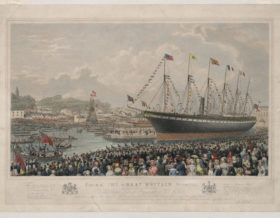Trade, tariffs and taxes
The Age of Revolution saw a British, followed by an international, move towards free trade. By the late 1700s, Britain’s economy had successfully developed, largely on the profits of slavery in the Americas and monopolisation by corporations like the East India Company in Asia. This overseas commerce was linked to several sectors of the British economy such as banking, insurance and, especially, manufacturing. British workers processed raw materials arriving from across the globe, and then exported finished products to an eager overseas market. As the industrial revolution took hold, productivity swelled supported by increasingly sophisticated financial and transporting systems and infrastructure. Other nations were prevented from ‘muscling in’ by a series of laws (such as the Corn Laws) and by Britain’s dominance at sea, where victories such as the Battle of Trafalgar saw off threats to global trade routes.
By the end of the Age of revolution, manufacturing – particularly textiles – and mining had replaced agriculture as the principal source of national wealth and Britain was in a position of global commercial domination. From this position, ‘protectionist laws’ could be relaxed, with a movement towards free trade presenting relatively little risk. But while the national income per capita was rising, distribution among British people was becoming increasingly unequal.


















